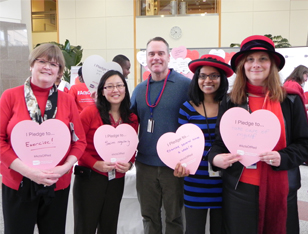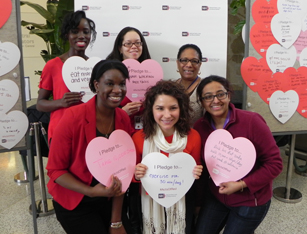

March 2015
IN THIS ISSUE:
![]()
- NIH Rare Disease Day promotes research, educates public and empowers patients
- New information helps better identify and treat immune system disorders
- Patients and families celebrate Valentine's Day at the Clinical Center
- Local high school students discover medical careers through yearlong program
- LabTV videos highlight the human faces of medical research at NIH
- Unlock a new career path: join the two-year NIH management intern program
- National Wear Red Day campaign promotes healthy lifestyles
- Dr. John P. Atkinson honored as NIH Distinguished Clinical Research Scholar and Educator in Residence
- Healthy participants needed for diabetes and vascular health studies
- Heavy lifting: life outside the lab
- Upcoming Events
Print this Issue ![]() (290 KB)
(290 KB)
ABOUT CC NEWS:
![]()
Published monthly by the Office of Communications and Media Relations. News, article ideas, calendar events, letters, and photographs are welcome. Submissions may be edited.
Clinical Center News
National Institutes of Health
Building 10, 10 Center Drive
Room 6-2551,
Bethesda, MD 20892-1504
Tel: 301-594-5789
Fax: 301-402-0244
Molly.hooven@nih.gov
2015 ISSUES:
![]()
QUICK LINKS:
![]()
NIH Rare Disease Day promotes research, educates public and empowers patients
 |
A poster session was available throughout Rare Disease Day for attendees to learn about the ongoing research at NIH. |
On Feb. 27 the eighth NIH Rare Disease Day took place at the Clinical Center in celebration and recognition of the importance of rare disease research. The event drew more than 500 people — the highest number of registrants than ever before – and an additional 329 viewers watched the event through an online videocast.
In the U.S., a rare disease is defined as one that affects fewer than 200,000 people. But, cumulatively, rare diseases affect the lives of upwards of 30 million people across the country — equivalent to roughly the population of Maryland, District of Columbia, Virginia, Delaware and Pennsylvania combined.
The day-long event began with opening remarks by Dr. John I. Gallin, director of the Clinical Center. Gallin encouraged a "free, healthy, robust discussion" of rare diseases. At the Clinical Center, nearly 1,000 rare disease protocols, or research studies, are taking place each year on more than 500 different types of rare diseases such as Cystic fibrosis, Huntington disease and certain types of muscular dystrophies. Around 50,000 patients come to the Clinical Center each year to participate in a rare disease protocol.
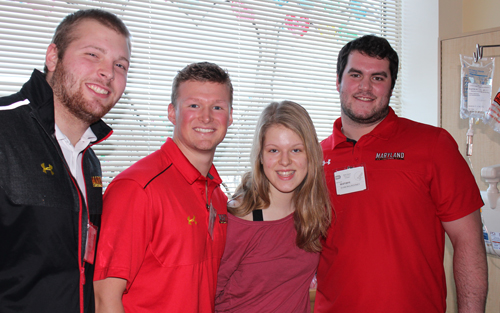 |
As part of Rare Disease Day, Uplifting Athletes from the University of Maryland football team visited patients at the NIH Clinical Center. Uplifting Athletes is a national nonprofit organization aligning college football with rare diseases and raising them as a national priority through outreach, research, education, and advocacy. |
U.S. Rep. Leonard Lance, R-NJ, spoke to the audience about the Rare Disease Congressional Caucus, which he has served on as the Republican chair for the last four years. With his, and many others' support, the Caucus continues to provide a forum for members of Congress to voice constituent concerns, share ideas, and build support for legislation that will improve the lives of people with rare diseases.
"I'm continually impressed with the leadership at NIH. I thank all who are here for your work, especially for your care and attention to the rare disease community," the congressman said.
"Today is about you. Today we are highlighting the tireless advocates for rare diseases who have come forward with great courage to speak to lawmakers and policy professionals."
A full day of panel discussions, poster sessions, and updates on advances in research and treatment helped raise awareness about rare diseases and their impact on patients' lives and their caregivers.
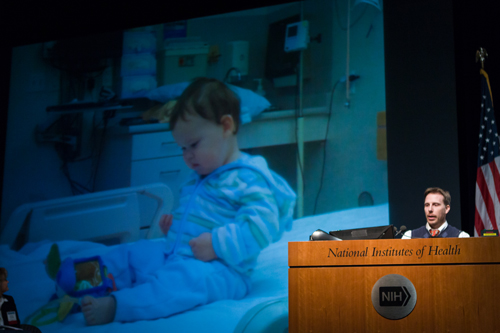 |
Matt Might, a father of an NIH pediatric patient, presents at Rare Disease Day. |
Matt Might, a father of an NIH pediatric patient, discussed his family's journey to create a community from the ground up around a diagnosis. His son is the first person to be diagnosed with an extremely rare disorder NGLY1.
"When you get a diagnosis you suddenly have one thing to focus on. Even if there are no medications available, the science becomes the medicine. You can make a difference. You can push the science," he said. In hopes to find others like his son, Might wrote a blog post that went viral and received millions of views in just a few weeks. A couple months later he found other patients around the world with the same condition.
"This turned that darkness of uncertainty into the light of day with community and science," he said. His son, and a handful of others, are currently participating in an NIH study.
New information helps better identify and treat immune system disorders
The human immune system protects the body from infection, but roughly 500,000 Americans suffer from a primary immune deficiency disease due to genetic defects. To more easily and efficiently identify the defects that could cause this disease, NIH experts are using a system that simultaneously tests a patient's DNA for a wide range of gene mutations associated with genetically-inherited immune disorders.
The Clinical Center's Department of Laboratory Medicine, in collaboration with the National Institute of Allergy and Infectious Diseases, have recently begun evaluating each specific patient's case. But there are more than 200 gene mutations that have been linked to primary immunodeficiency diseases, and that number is growing.
People with these diseases can often get infections that are severe, long lasting, hard to cure and potentially life threatening.
The genetic defects cause essential parts of the immune system to be either missing or not working properly.
Prior to the new approach, scientists had to make an informed guess when choosing which individual genes they should evaluate as they try to identify the specific immune system disorder in an individual patient. Scientists know now that the range of symptoms linked to specific gene mutations is far wider than previously realized. Accurate identification of the genetic defect in an individual patient leads to better, more targeted treatment as well as more effective genetic counseling.
This new approach to genetic evaluation not only improves the ability to identify and treat these diseases, but also saves time and expense, according to Dr. Sergio Rosenzweig, deputy chief of the Immunology Service in the Department of Laboratory Medicine.
Furthermore, the new identification process at NIH results in rapid generation of the results.
"We are gaining this knowledge at a fast pace, and worldwide, with multiple centers applying similar approaches. We are seeing the identification of almost one new gene defect per month linked to immune disorders," said Dr. Thomas Fleisher, chief of the Department of Laboratory Medicine.
Once the genetic evaluation is completed and linked to additional laboratory studies as well as the clinical presentation (signs and symptoms associated with a disease), a definitive diagnosis can be established and appropriate treatment initiated, representing true bench-to-bedside clinical care.
Overall, these findings result in a better understanding of how the immune system handles the vast microbial exposure a typical person encounters in his or her lifetime. Patients with immune system disorders are not able to effectively protect themselves, and this new method helps scientists better understand the underlying reasons for their clinical presentation at the same time that treatment is initiated.
Patients and families celebrate Valentine's Day at the Clinical Center On Feb 12, pediatric patients stepped away from their hospital room to spend quality time with friends and family to celebrate the Valentine's Day holiday. With a break from the stress of the medical environment, the patient above enjoyed decorating and personalizing candy bars with members of his family. The Clinical Center program was provided by the Recreation Therapy Section in the Rehabilitation Medicine Department. |
Local high school students discover medical careers through yearlong program
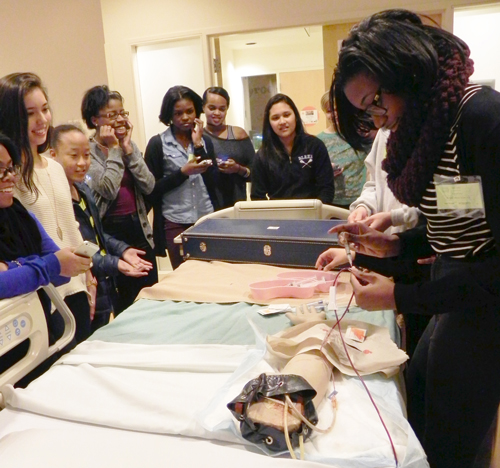 |
While visiting the Nursing Department, students received hands-on experience performing a mock blood draw. |
The NIH Clinical Center's Discovery Program, which began in September 2014, is in its first year of providing local minority high school students with an opportunity to explore career options in health care and establish a pipeline for their continued engagement in the health sciences.
Once each month during the school year, 13 students from Blake High School in Montgomery County visit different departments or sections within the Clinical Center to learn about their mission and the individuals who are a part of the team.The students have visited Rehabilitation Medicine, Nutrition, Pharmacy, Nursing, Radiology and Imaging Sciences and Perioperative Medicine. Before the end of the school year, the students will visit Laboratory Medicine, Transfusion Medicine and Epidemiology as well.
"The goal for each department is to give an overall picture of available careers and how they all work together," said Courtney Duncan, volunteer services program coordinator in the Clinical Center's Social Work Department. Duncan is the founder and driving force behind the program. "I kept hearing the same request from high school students, that they wanted to volunteer to learn more about what we do here because they just weren't sure," she said. "I wanted to highlight the Clinical Center and all of the wonderful things it has to offer, and excite students about careers they may not be familiar with."
Duncan knew of career exploration programs at other hospitals and decided to start a similar program. After looking at schools in the area with a high minority population, and those with no previous NIH partnership, she identified Blake High School to participate. The school's staff was excited about the partnership and has been instrumental in identifying students who would flourish in the program. To participate, students must have a 3.0 GPA, an interest in health care and a commitment to attending the monthly after-school visits.
"I was looking for students who seemed genuinely interested in learning about all of the options, and who were unsure about which area of health care they would pursue," Duncan said. "They also had to be enthusiastic, determined and they had to demonstrate a serious interest in healthcare and science."
Participant Ericka Njeumi, a junior, didn't know that much about the NIH before joining the program.
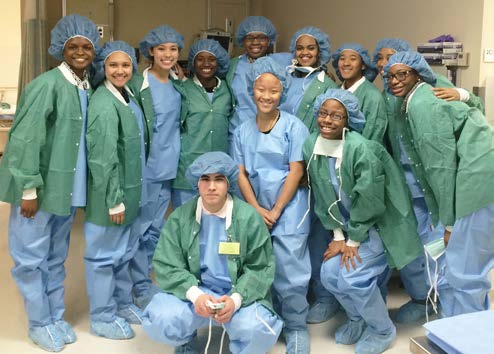 |
On Feb. 19, Blake High School students visited the operating room. |
"You can hear about careers in the sciences in school but never really understand them. In the program, we're actually able to see the different aspects of the day-to-day worklife. To actually experience it makes us really lucky," Njeumi said.
Already, Duncan can tell that the Discovery Program has been successful in exciting teens about careers in health care.
"They love it," she said of the students. "They have been enthusiastic and engaged, and they cannot wait for the next session. I have been working with them to think about their next steps in staying connected to the NIH. Many are in the process of applying to summer programs."
Despite only being halfway through the program in February, Ben Cabrera said his interest in science has already increased tremendously.
"When I came into this program, I was sort of close-minded. I just did this because I wanted to be at the NIH, and it sounded so cool," he said. "Then, as I came into the medical field, I realized that I actually want to pursue something like nursing or cancer research. My interest has increased so much through this program. One of the nurses told me last month ‘When you come here, you come into a family.' I really love that."
For Asorai Dhaba, a junior, the experience has really made her think OK, this could be my daily life!
"I had no knowledge about the medical field, so this is a great opportunity. The program gives you hands-on experience, and you actually have one-on-one time with those who were once in your footsteps," Dhaba said. "I always felt like there are only a few kinds of things you can do in medicine: be a nurse or be a doctor. But here I learned that you can do so many different things, like be in a lab and do experiments. It's really interesting because I'm really active in experiments in my biology class. I think I like this, and that I can do this!"
Duncan and other staff have found the program rewarding as well.
"Seeing their excitement when they learn something new or see something they had not seen before is really rewarding," she said. And the school has already contacted me about when we will start the new application period for next year's program!"
LabTV videos highlight the human faces of medical research at NIH
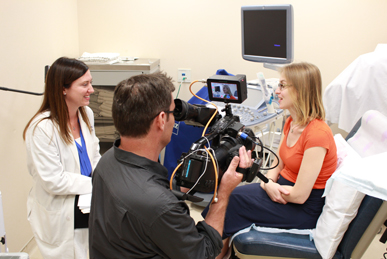 |
Dr. Erin Wolff (left) talks with a colleague and demonstrates the collaborative atmosphere of research. |
In hopes to inspire young people across the world to pursue a career in the sciences, the NIH has collaborated with LabTV [disclaimer] to develop a series of mini-documentary videos featuring scientists across campus.
LabTV was founded by [disclaimer] Jay Walker, the curator and chairman of TEDMED, and includes executive producer David Hoffman, a documentary filmmaker who's work has been featured on PBS, Discovery, A&E among others.
The project, which began in June 2014, now includes over 120 video interviews with medical researchers, including nearly all 42 of the NIH Medical Research Scholars Program participants.
Together, with the filmmakers, the NIH participants are able to take complex scientific studies and present them in a straight forward style that's easily understood by – and exciting to – high school and undergraduate students.
The dedicated young scientists who participated in the filming also shared details of their personal journey to where they are today – things that could be relatable to viewers. They answered questions like: Where did you grow up?; Did you always want to be a scientist?; What challenges have you had to overcome?
Christopher Hourigan [disclaimer], a LabTV participant and physician scientist in the National Heart, Lung, and Blood Institute, told viewers not to be discouraged by schoolwork.
"I really didn't like school. But I spent a summer in a lab and thought wow, this is great. Actually doing science is different from school. It's fun" he said in his video. "You don't have the be the smartest person in the world. You have to care and you have to stick at it."
LabTV hosts the NIH videos showcasing the human faces of medical research on its interactive website, which is geared toward interested young people, their parents, educators and other influencers. The personal video stories are showcased on web and mobile platforms as well as a dedicated channel on YouTube [disclaimer].
Each week, additional videos are added to the website. View and share the videos of NIH experts helping lead the way [disclaimer].
Unlock a new career path: join the two-year NIH management intern program
The NIH Training Center has announced that the new recruitment season for the Management Interns Program will take place April 6 – 10, 2015. The program is a highly competitive, two-year career-development program for current NIH employees.
Management interns come from a variety of job backgrounds, including both scientific and administrative fields. Upon completion of the program, management interns transition into an administrative-management career in one of many areas throughout the NIH enterprise.
Eligible employees are invited to apply online and attend an information session:
March 20, 2015, Noon to 1:00 p.m. Building 31, 6C Room 10
March 24, 2015, Noon to 1:00 p.m. Building 10, FAES Rooms 3-4
March 25, 2015, Noon to 1:00 p.m. Teleconference (restricted to employees outside the DC Metro area. Email MI_Info@mail.nih.gov for dial in information.)
April 1, 2015, Noon to 1:00 p.m. Rockledge 1, Suite 4000, RT1
National Wear Red Day campaign promotes healthy lifestyles
NIH staff and patients joined together in the Clinical Center atrium Feb. 6 to celebrate National Wear Red Day and to participate in a social media campaign called "Acts of Red," which focuses on simple steps to prevent heart disease and maintain a healthy lifestyle. On heart-shaped pieces of paper, staff jot down public pledges to protect their hearts and live healthy lives. People pledged to go swimming once a week, think positively and act positively, reduce sugar intake, quit smoking and eat more vegetables. Participants posed for photographs and held up their pledges. The photos were shared on NIH social media accounts such as Facebook, Twitter and YouTube [disclaimer]. The event was sponsored by the National Heart, Lung, and Blood Institute. |
Dr. John P. Atkinson honored as NIH Distinguished Clinical Research Scholar and Educator in Residence
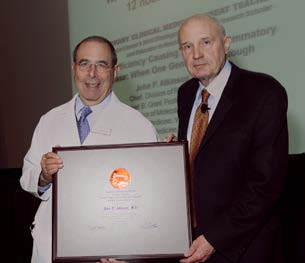 |
Dr. John I. Gallin, director of the Clinical Center (left), presents the honor to Dr. John P. Atkinson following the lecture. |
Dr. John P. Atkinson, a renowned researcher in autoimmunity and chronic inflammation, is this year's Distinguished Clinical Research Scholar and Educator in Residence, the third to be so honored. Atkinson, a Samuel B. Grant Professor of Medicine, Professor of Molecular Microbiology and Chief of the Division of Rheumatology at the Washington University School of Medicine in St. Louis, was the speaker at the Clinical Center Grand Rounds lecture Feb. 11.
Atkinson's research focuses on complement regulatory proteins, a system of proteins abundantly present in blood that help to destroy disease-causing bacteria and viruses. His clinical activities center on patients with immune dysfunction including lupus, immunodeficiencies and rare inflammatory disorders. His lab's recent clinical and translation activities have focused on identifying genetic mutations in complement inhibitors predisposing to human diseases.
He spoke about the effects of such mutations predisposing to atypical hemolytic uremic syndrome and age-related macular degeneration. One particularly interesting aspect of this work is the implication that immune modifiers with a strong genetic basis, probably designed to protect babies from infection, have a tendency to "backfire" in old age. By this he means that evolutionarily-driven alterations that protect, for example, against a lethal strep or plague bacillus infection in childhood, may cause trouble (too much inflammation) when our immune systems have to deal with biologic debris, such as in age-related macular degeneration.
Atkinson has a long association with NIH. In the 1970s, he was a clinical associate under Dr. Shelly Wolfe, who greatly influenced immunology and infectious diseases research within the National Institute of Allergy and Infectious Diseases Laboratory of Clinical Investigation.
His dedication to the NIH community continued beyond the lab as well.
Atkinson served as Chairman of the Clinical Center's Board of Scientific Counselors, on the National Advisory Council for the National Institute of Arthritis and Musculoskeletal and Skin Diseases and as an external advisor for the NIH Undiagnosed Diseases Program. He serves on the National Human Genome Research Institute Board of Scientific Counselors and will become chairman of the board in the fall.
Atkinson has trained more than 70 pre-doctoral students and postdoctoral fellows, many of whom have gone on to distinguished careers in academia, government and the biotechnology and pharmaceutical industries.
"NIH was and is a great place to train as a physician-scientist," he said. "I feel like NIH is my second home. I was so fortunate to be exposed to and learn how to perform clinical investigation. I still have a hard time believing that someone would actually pay me to do exciting detective work on the etiology, pathogenesis and treatment of human disease in such a great place."
In addition to presenting the Grand Rounds lecture, Atkinson met with medical students, fellows in a variety of disciplines and investigators from a number of institutes during his two-day residence as part of this achievement. The Distinguished Clinical Research Scholar and Educator in Residence is supported by funds the Clinical Center received as part of the Lasker- Bloomberg Public Service Award in 2011.
Healthy participants needed for diabetes and vascular health studies
National Institute of Diabetes and Digestive and Kidney Diseases
NIDDK seeks healthy males, ages 18-45, without diabetes, to participate in a research study (14-DK-0195). Doctors want to learn how a new FDA-approved diabetes medication affects bone health in healthy men. Meals are provided and you will have outpatient visits and inpatient stays. Compensation is provided.
National Institute of Nursing Research
Healthy older adults ages 55-75 are invited to participate in an outpatient research study (14-NR-0034) investigating the benefits of omega-3 oil and blackcurrant supplements on vascular health. The goal of the study is to determine whether the supplements improve blood flow and blood vessel function, which can affect your heart. Eligible participants must bemedication-free and in good general health. The study will be carried out in an outpatient clinic and includes four visits over six months. Compensation is provided.
For more information on the studies above or others available, please call the NIH Office of Patient Recruitment 1-866- 444-2214, (TTY 1-866-411-1010) or visit www.clinicaltrials.gov.
Heavy lifting: life outside the lab
 |
Mike Sipes, a lab technician within the Clinical Center, pulls the bar from the floor to overhead in one continuous movement — an Olympic-style weightlift known as a snatch. |
As the work day comes to a close and the rush begins to exit the NIH campus, the real heavy lifting is just starting for Mike Sipes, a technician for the National Cancer Institute's Biochemical Laboratory of Pathology within the Clinical Center.
After running experiments and caring for the lab, the 56-year-old father of five girls finds the time to balance work, family life — and weights. Sipes, along with several other employees in the NIH Weightlifting Club, heads to the gym on campus in building T39 to participate in Olympic weightlifting [disclaimer].
"Weightlifting seems like a brute sport but it's not," Sipes said. "Someone told me Olympic weightlifting was like jazz. It's an intellectual lift. It's a combination between strength, coordination and hardheadedness."
NIH participants, both males and females ranging in age from 18-56, practice for competitions that take place in the local area. Most people who join the club are beginners, and not all participants do the Olympic-style weightlifting. The club also promotes power-lifting and general strength training, each tied to the same basic idea that free-weight training is a great way to become strong and fit.
Sipes encourages fellow researchers, especially those over 35, to leave the lab bench and give lifting a try. "[As NIH employees], not only are we looking for scientific breakthroughs in health, but we are taking care of our own health. It's functional fitness," he said.
Indeed, Clinical Center staff are known for their strong minds and strong hearts. Through the NIH Weightlifting Club, the staff can develop strong bodies to match.
Upcoming Events
Most lectures will be streamed live and archived
Contemporary Clinical Medicine: Great Teachers Lecture
From Physician to Patient to Poet
March 11, 2015, Noon – 1:00 p.m.
Lipsett Amphitheater
Presented by Laura Liberman, MD, Memorial Sloan-Kettering Cancer Center.
NIH Director's Wednesday Afternoon Lecture Series
The Annual Margaret Pittman Lecture
The Biology of CRISPRs: From Genome Defense to Genomic Engineering
March 11, 2015, 3:00 p.m. – 4:00 p.m.
Masur Auditorium
Presented by Jennifer Doudna, PhD, University of California, Berkeley.
The Trans-NIH Center for Human Immunology (CHI) Grand Rounds Lecture
A Systems Approach to Understanding Human Immunity
March 18, 2015, Noon – 1:00 p.m.
Lipsett Amphitheater
Presented by Neal Young, MD, NHLBI/ CHI, John Tsang, PhD, CHI and Robert Nussenblatt MD, NEI.
National Symphony Orchestra
March 25, 2015, 1:30 p.m.
Hatfield Building, North Atrium
A woodwind ensemble concert, co-presented by the FAES and the Clinical Center.
Clinical Center Grand Rounds Lecture
Gaucher Disease and Parkinsonism: Using Induced Pluripotent Stem Cells to Probe the Link Between a Rare and a Common Disorder
Clinical and Molecular Characteristics of Erdheim-Chester Disease
March 25, 2015, Noon – 1:00 p.m.
Lipsett Amphitheater
Presented by Ellen Sidransky, MD, NHGRI and Juvianee Estrada-Veras, MD, NHGRI.
NOTE: PDF documents require the free Adobe Reader.
 The information on this page is archived and provided for reference purposes only.
The information on this page is archived and provided for reference purposes only.